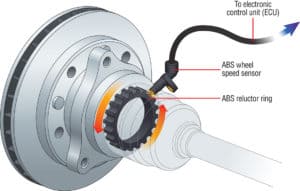ABS Light is on Inspection Cost:
Starting From $80



The Anti-Lock Brake System (ABS) Light
This light turns on when there’s any problem with the anti-lock brake system (ABS) in your car. The ABS is an automated safety mechanism that allows your car to brake safely without skidding. It works by recognizing when wheel rotation stops during driving and remediates this by releasing pressure from the brake fluid. As occurs with other parts of the car, the ABS system may develop problems. And this should be unexpected. However, swift resolution can go a long way in preventing driving risks.
The ABS light might come on for many reasons including:
Bad Wheel Speed Sensor: The wheel speed sensors provide the information needed for the ABS system to work. Located inside the transmission or wheel hub, these sensors detect the speed of wheel movement and pass this information to the ABS. Where there are discrepancies in the wheel speed movement, the ABS ensures brake fluid pressure is released. This normalizes car movement. However, if the wheel speed sensor is faulty, no information will be passed to the ABS. A common problem with the wheel speed sensor is it’s susceptibility to heat damage, usually caused by its close proximity to the braking system.
Defective Hydraulic Pump or Valve: The hydraulic pump or valve is responsible for increasing brake fluid pressure once the wheel sensor signals an imbalanced wheel speed. The pressure released keeps the wheels firmly grounded and prevents skidding. Dirty brake fluid is usually the bane for hydraulic pumps. It may lead to wear and tear that may render the hydraulic pump/valve ineffective in the long run.
Faulty ABS Module: If the ABS module is faulty, for example, due to corrosion, information relay from the wheel speed sensor to the ABS system will expectedly be impeded. It’s not uncommon for wheel speed sensor wires to go dysfunctional when corroded. They can also lose their activity even when only slightly corroded. As the ABS module can go bad for some reason, prompt replacement can only be your best step to forestall driving risks.
Low Fluid Levels: If fluid levels are low, there will be little to no pressure available for the ABS to perform optimally. Present in excess, air can also affect how reliable the ABS system works in regulating pressure.
Getting started:
An expert mechanic will need to inspect the ABS system to zero in on the cause of the problem. The report of this inspection will guide the decision on the extent of damage and associated repair costs.
The process:
Usually, a scan tool will be used to “communicate” with the ABS module to identify the specific cause of the issue. The ABS fuse and other accessories will also be checked to ensure a reliable solution is proffered.
Why this service is important for your car:
The safety role of the braking system cannot be overemphasized. If the ABS light indicator comes on, chances are high that brake performance is already compromised. If this occurs, have a professional mechanic assess the problem as soon as possible to forestall extensive repair costs and safety hazards.

How it Works

Get A Quote

Book Appointment

Get Your Car Diagnosed
Google Reviews










Cities We Serve
- ABS Light is on Inspection Service in Downtown Toronto, ON
- ABS Light is on Inspection Service in North York, ON
- ABS Light is on Inspection Service in Mississauga, ON
- ABS Light is on Inspection Service in Richmond Hill, ON
- ABS Light is on Inspection Service in Ajax, ON
- ABS Light is on Inspection Service in Pickering, ON
- ABS Light is on Inspection Service in Markham, ON
- ABS Light is on Inspection Service in Scarborough, ON
- ABS Light is on Inspection Service in Etobicoke, ON
- ABS Light is on Inspection Service in Brampton, ON
More Specific ABS Light is on Inspection Estimates
- Mercedes-Benz ABS Light is on Inspection
- BMW ABS Light is on Inspection
- Acura ABS Light is on Inspection
- Nissan ABS Light is on Inspection
- Ford ABS Light is on Inspection
- Mazda ABS Light is on Inspection
- Hyundai ABS Light is on Inspection
- Honda ABS Light is on Inspection
- Toyota ABS Light is on Inspection
- Volkswagen ABS Light is on Inspection
